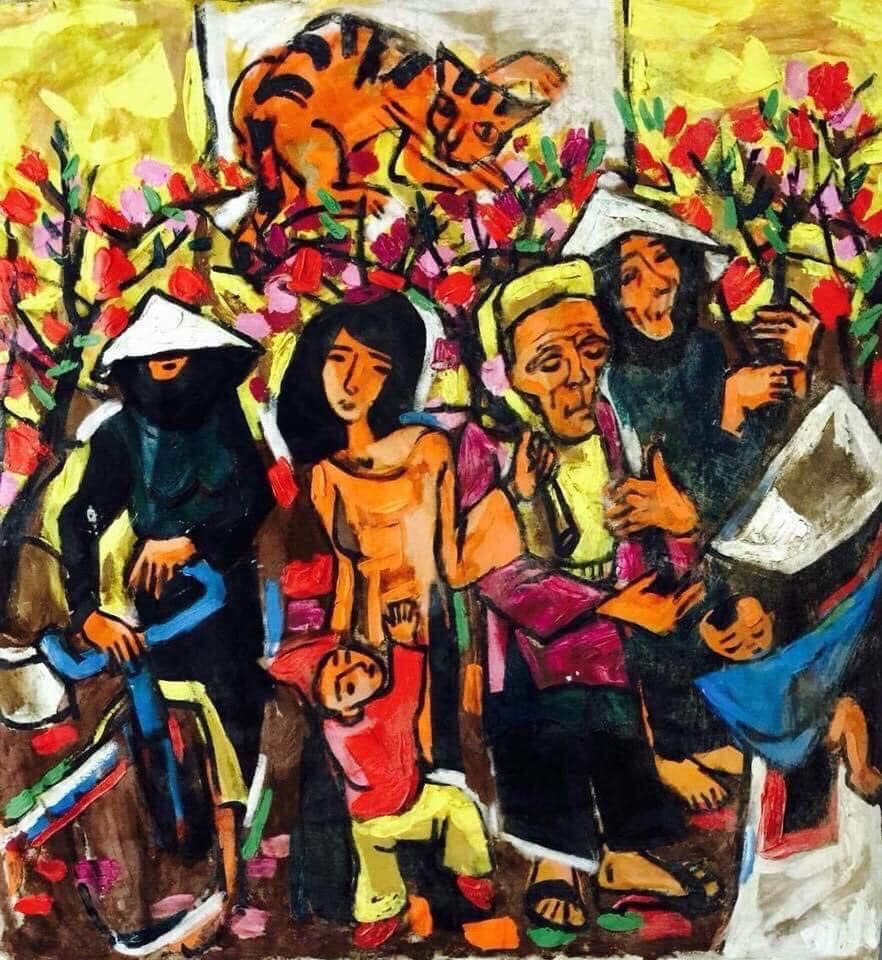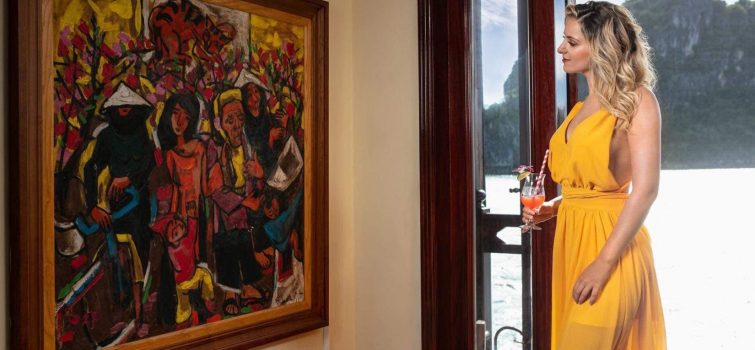Paintings depict both the cultural heritage and the historic values of a nation
On the occasion of Pham Luc’s most recent exhibition from 24 April to 6 May 2019, with the meaningful title ‘Xuan 2019’ (“Spring 2019”), the shortest introduction I have ever seen summed up his life of art as “35 years in army service, 55 years as an artist and 77 years of being a Vietnamese. My motivation continues to be to use my life experiences as a source of inspiration to create works of art.”
Pham Luc – a celebrated artist who creates pieces of art from images that he has seen in his dreams. Pham Luc, the creator of thousands of pictures of various sizes, styles and materials, some of which you can admire aboard Heritage Cruises, shares with us his vision, passion, war memories, and life as a soldier and artist.
Pham Ha: You were born in Hue, your father’s home town, and lived there until 1945, when you moved to Ha Tinh at the age of three, your mother’s homeland. After graduating from the Vietnam College of Fine Art in the mid-1960s, you joined the Vietnamese army. Was becoming a soldier and an artist serving in the army your only choice at that time?
Pham Luc: My father was a junior mandarin in the Nguyen Dynasty. He met my mother in Ha Tinh, and she gave birth to me when they lived in Hue. In 1945, there were plenty of political fluctuations due to the stiff resistance of Vietnamese inhabitants against the French protectorate in Hue. It was feared that there would be a revolution, so my father sent his wife and three children away from Hue to settle down in the central coastal province of Ha Tinh.
I grew up in my mother’s home town and, as a little boy, I was passionate about drawing, which I was very good at in school, rather than other subjects. After finishing secondary school, I went to Hanoi to study an intermediate art course at the Vietnam College of Fine Arts. I graduated and worked at the Cultural Department of Ha Dong in Ha Tay province (now Hanoi) for a short period of time, then joined the Vietnamese military.
At that time, all my classmates volunteered for the army as there was a lot of spirited nationalist fervour in North Vietnam. Everybody wanted to join the army, rather than stay at home, as they felt that they wanted to do something to fight to bring about the nationalist ideal of unifying both North and South Vietnam.

Pham Ha: Do you think that abiding by rules and following orders in the army was difficult for you as an artist, and your creativity was restricted?
Pham Luc: In the army, I chiefly worked in the Military Literature and Arts Department, mainly teaching drawing. Every 3 months, we had a new class of young soldiers to train who were either involved in propaganda or were sent to fight in South Vietnam, Laos and Cambodia.
Sometimes, I had to go on temporary assignments to various army units to teach drawing. My role in the military did not prevent me from my own artistic creations, as during this time I had the opportunity to learn about different techniques in terms of mesh printing, silk printing, and lacquerware. Prior to joining the military, I learnt how to use a variety of materials for drawing, including on canvas, and attended a graphics class at the college.
Visiting different military units, getting acquainted with the daily routines of the soldiers and indigenous people, gave me a lot of ideas for paintings.
Pham Ha: From the number of your paintings that still exist from the war period, it is clear that you weren’t able to paint as much as you would have liked, but these paintings have made a strong impact on fans of your work because of the subject matter, the material used, the colors, and the brushes you used. Was this the most extraordinary period of creativity for you?
Pham Luc: Due to the situation I found myself in during the war, there was no place for me to store my work safely, so there were many more drawings but not all of them survived.
The Military Artist Studio was provided with art materials from a variety of countries, like the Soviet Union, China, and East Germany; we had enough colors to choose from, but the material available was mainly burlap. Therefore, we had to paint a layer of egg white or cowhide glue before we could start to paint and, as a result, the pictures easily became mouldy and deteriorated.
Wartime conditions did not allow me time to paint at leisure, but I was passionate about drawing and created a lot of pictures at high speed. I took advantage of the jute bags used to store guns, ammunition, and medicines or the linings which contained machinery components and then “made up” some basic colors from motorcycle exhaust, soot, and car paint.
The war was the second stage of my creative process, which started when I was at college. In school I drew from instinct, learning the rules from my teachers. In the army, however, I was older and more mature, no longer young and inexperienced. Moreover, the struggle of my people affected me deeply and I drew on many new emotions for my drawings.
When we were being attacked, with loud explosions from bombs and gunfire, it was impossible to work on my art. But the depth of my emotions in such difficult situations, and my ability to paint quickly, meant that my work came from the heart and reflected the spirit of the people around me.
Pham Ha: Your quick and expansive brushwork has become your easily recognized bold and impressive style since the war. Is it important that you portray an overall impression in your work rather than concentrating on details?
Pham Luc: I remember a Vietnamese folk verse: “Trên đồng cạn dưới đồng sâu. Chồng cày vợ cấy con trâu đi bừa.” (The upper field is dry, the lower one is deep/Husband plows, wife transplants rice seedlings, buffalo tilling).
If you consider the detail you would start to wonder who is doing the plowing, whether the buffalo does it on his own or is he guided by the husband to keep the furrows straight. Generally, people don’t pay much attention to the detail; they focus on the overall impression of the image, the people and animals at work. Art is the same, there is no need to depict detail.
When I was learning the techniques of painting at school, my work was guided by others, just as the buffalo is guided by the farmer. By restricting myself to the style I was taught, I would not have been able to pursue my own creativity. Images and emotions come to me in my dreams and I feel that these are sent to me so that I can draw them
Pham Ha: Do you find you are continually looking for new subjects and styles as you still want to improve, even though you are so successful?
Pham Luc: Although my art does not go into detail and there are no specific answers in the content of the paintings, the overall images in the drawings convey my thoughts and feelings.
A beautiful painting can pose questions for the viewer as it is not always easy to understand the message conveyed by the artist. It is a challenge for the viewer to understand and acknowledge the familiar images.
I don’t make sketches before I start to paint, but I do plan in my head what I want to do. Some of my images are quite abstract but overall the paintings, and in particular the colors I use, illustrate the type of characters that came from the dreams that have inspired me.
Pham Ha: As a painter and soldier, you have lived in in both the 20th and 21st centuries, through three wars. You have painted when at war and in peace time, have your life experiences enabled you to understand all the many aspects of Vietnam and how it has progressed? Personally, your artworks and memories about the war have touched my heart and your paintings of people’s lives, culture, costumes, and heritage are an important contribution to the preservation of Vietnamese historical and cultural values. What are your thoughts on this?
Pham Luc: An artist paints their personal perception of the world through composition, color and images. Paintings depict both the cultural heritage and the historic values of a nation. Culture because paintings reflect the observations of our surrounding world, expressing its uniqueness. Historic values because the paintings depict our lives, joys, and sorrows in the past, present and future. I am so happy that art collectors and luxury cruise owners have collected my work to show art lovers and the younger generation the natural and cultural heritage of our country, and to help them appreciate the work of local artists and understand our culture and history and, in particular, the progress of Vietnam in recent times.
Thank you for your sharing your memories and thoughts with us in this exclusive interview.

